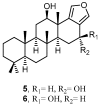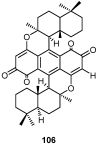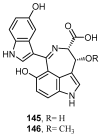Bioactive Natural Products of Marine Sponges from the Genus Hyrtios
- PMID: 28492499
- PMCID: PMC6153753
- DOI: 10.3390/molecules22050781
Bioactive Natural Products of Marine Sponges from the Genus Hyrtios
Abstract
Marine sponges are known as a rich source for novel bioactive compounds with valuable pharmacological potential. One of the most predominant sponge genera is Hyrtios, reported to have various species such as Hyrtios erectus, Hyrtios reticulatus, Hyrtios gumminae, Hyrtios communis, and Hyrtios tubulatus and a number of undescribed species. Members of the genus Hyrtios are a rich source of natural products with diverse and valuable biological activities, represented by different chemical classes including alkaloids, sesterterpenes and sesquiterpenes. This review covers the literature until June 2016, providing a complete survey of all compounds isolated from the genus Hyrtios with their corresponding biological activities whenever applicable.
Keywords: Hyrtios; alkaloids; bioactive; marine natural products; marine sponges.
Conflict of interest statement
The authors declare no conflict of interest. The founding sponsors had no role in the design of the study; in the collection, analyses, or interpretation of data; in the writing of the manuscript, and in the decision to publish the results.
Figures








































References
Publication types
MeSH terms
Substances
LinkOut - more resources
Full Text Sources
Other Literature Sources
Molecular Biology Databases

